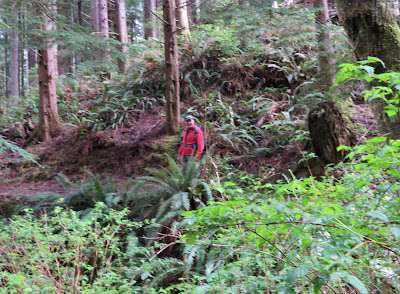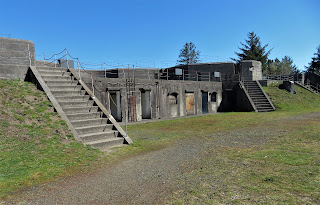Blogger is killing me
I am not sure what is going on with Blogger. But as I was jotting some thoughts down, it suddenly published. A couple of posts ago, blogger published while I was doing laundry. I had checked the time stamp to see if I had done it expectantly and saw that I was not even online at the time.
I deleted the last post and decided to start over and see if I could do it right this time. Here we go again.
We had been riding our mountain bikes near Fort Clatsop and came upon the Fort to Sea Trail. Since part of the trail allowed bikes, we rode up to the Overlook 2 miles up the path.
It was so much fun that we did it twice. We were then committed to trek the entire 6.5 miles of the trail once our curiosity got the best of us.
After Lewis and Clark's Corps built Fort Clatsop, they began exploring the land nearby. The Fort To Sea Trail winds its way through the woods south of Fort Clatsop to Sunset Beach on the Pacific Ocean, covering land that once was home to the Clatsop Indians who helped the Corps.
Oops, we had to turn around. We decided this part was hiking only. Good try Mike.
They say you can see the ocean from here. I only saw clouds both times we got to the lookout. We did hear the ocean waves crashing as we hiked down the canyon 5 miles away.
At times it reminded us of hiking in Costa Rica but much cooler.
Mike is tired of looking at this North Face hiking top I have had for 16 years. It was made from recycled plastic. After one of our hikes, he took me to the Helly Hansen store and instructed me to find a lightweight fleece and buy it. Then he suggested that I get rid of the old fleece that had gotten pretty short on me. As you can see in the picture below, I still have it. When you find a hiking top that keeps you comfortable in lots of conditions, it is hard to let it go. Even if it looks wrong. It is a process and I am working on it.
Enough about my shirt. We reached the top of the Ridge again and took the Kwis Kwis Trail back down which had a lot more ups and downs than the Fort to Sea Trail but not hard at all.

We descended through deep woods and reach wooded pasture dotted with small lakes. The wooded pasture leads to the crossing tunnel under U.S. Highway 101 and near Camp Rilea.

The coastal mountains on a sunshiny day.
We did the trail over three days since we weren't sure what to expect in a 10 mile hike with an out and back. The two hiking days were each 5 miles round trip due to the limited parking options. We had to hike some of the section twice but that was just fine. We tried one road marked with a trailhead sign that took us through potholes into a sketchy looking area. We opted against that parking place, made our way back to the Presbyterian Church which had a sign welcoming hikers except on Sunday mornings. Thanks to them.
Some people park a car at each end of the trail and hike through. Others call a cab to meet them at one end and take them back to their cars.
The trail runs through farm land that is fenced on both sides. It amazed us the amount of cooperation it had to take between the land owners and forest service for this to get done.
This stretch of the trail marks the beginning of sandy soil and gentle dunes and leads into beach woods before arriving at the Sunset Beach/Fort to Sea Trail parking lot.
The 1-mile path to the beach.
This well maintained trail had so much diversity to enjoy with lots of birds singing just adding to the experience. The forest service has put a lot of work and money into this great trail.
Back to the not so hard job of selling wood and visiting with campers in the evening.








































